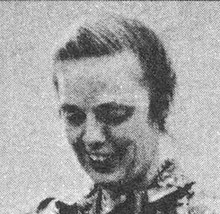|
Bess Lomax Hawes
Bess Lomax Hawes (January 21, 1921 – November 27, 2009) was an American folk musician, folklorist, and researcher. She was the daughter of John Avery Lomax and Bess Bauman-Brown Lomax, and the sister of Alan Lomax and John Lomax Jr. Early life and educationBorn in Austin, Texas, she excelled at classical piano as a child under the tutelage of her mother. Later, she learned to play the guitar. She learned folk music from a very early age, since her father, a former English professor and twice president of the American Folklore Society, was Honorary Curator of American folk songs at the Library of Congress from 1935 to 1948. He collected and published cowboy songs as early as the 1900s. He and her brother, Alan, traveled the South for the Library of Congress recording rural musicians who had not been influenced by the radio. At the Louisiana State Penitentiary at Angola during their first trip, they recorded Huddie Ledbetter (“Leadbelly”) who went on to become a successful and influential performer of traditional African-American music. During the years that followed, her father and brother worked with many other folklorists, musicologists and composers from all over the world and recorded more than 10,000 records of vocal and instrumental music. They were responsible for introducing American audiences to other folk musicians and blues artists such as Muddy Waters, Woody Guthrie, Josh White and Burl Ives. She entered the University of Texas at fifteen and the following year assisted her father, John, her brother, Alan and modernist composer Ruth Crawford Seeger with their book, Our Singing Country (1941). She went on to graduate from Bryn Mawr College near Philadelphia with a degree in sociology. Later, during the 1960s, she was among the first group of students to receive an M.A. in folklore at the University of California at Berkeley, under the guidance of professor Alan Dundes. Career in music and folk artsIn the early 1940s, she moved to New York City, where she was active in the folk music scene. She was an on-and-off member of the Almanac Singers She and fellow Almanac singer, Baldwin "Butch" Hawes, an artist, were married in 1943.[1] Another Almanac member, Woody Guthrie, taught her mandolin. During World War II, Bess Lomax Hawes worked for the Office of War Information preparing radio broadcasts for troops overseas. After the end of the war, she and her family moved to Boston where she wrote songs for Walter A. O'Brien's 1949 mayoral campaign including "M.T.A.," co-written with Jacqueline Steiner. The song became a hit for The Kingston Trio in 1959. While her children (Nicholas Hawes, Corey Hawes Denos, and Naomi Hawes Bishop) were attending a cooperative nursery school organized by graduate students at MIT and Harvard:
In the 1950s, she moved to California, where she taught guitar, banjo, mandolin and folk singing through UCLA Extension courses, at the Idyllwild summer arts program and, starting in 1963, at San Fernando Valley State College. She also played at local clubs as well as at some of the larger folk festivals such as the Newport Folk Festival and the Berkeley Folk Festival. In 1968, she became associate professor of Anthropology at San Fernando Valley State College and later head of the Anthropology Department at what is now Cal State Northridge. In 1971, her husband, Butch, died. In 1975, Hawes accepted a position in administration at the Smithsonian Institution, where she was instrumental in organizing the Smithsonian's 1976 Bicentennial Festival of American Folklife on the National Mall. In 1977, she was named first director of the Folk and Traditional Arts Program at the National Endowment for the Arts, and created the National Heritage Fellowships, which recognize traditional artists and performers. During her tenure, funding for folk arts rose from about $100,000 to $4 million, and 50 state or territorial folk arts programs were set up:
She retired in 1992. Bess Lomax Hawes was the recipient of an honorary doctorate from the University of North Carolina and the National Medal of Arts in 1993 awarded by President Bill Clinton. An NEA traditional arts award is named in her honor. Her memoir, Sing It Pretty, was published by Illinois University Press in 2008. Death and legacyWhile a faculty member at California State University Northridge, Hawes compiled an extensive archive of folk songs that were gathered by her students in Los Angeles and abroad. The archive is held in the Special Collections and Archives section of CSUN's University Library.[2] She died in November 2009, at the age of 88, following a stroke in Portland, Oregon.[3] Bibliography
Filmography
Notes
External links
|
||||||||||||||||
